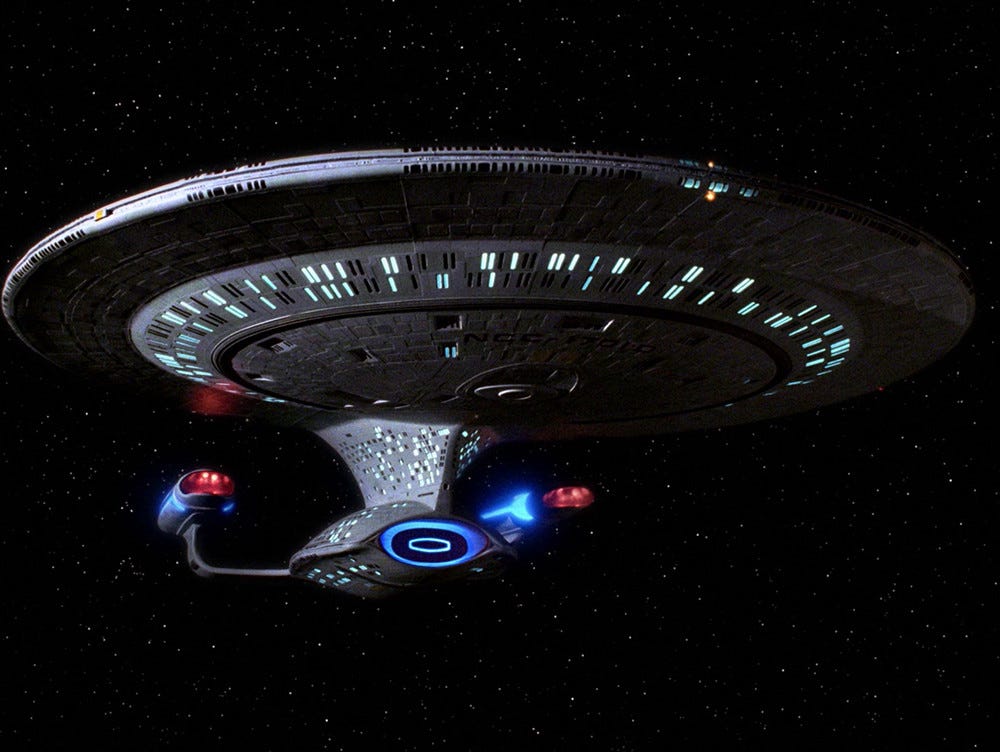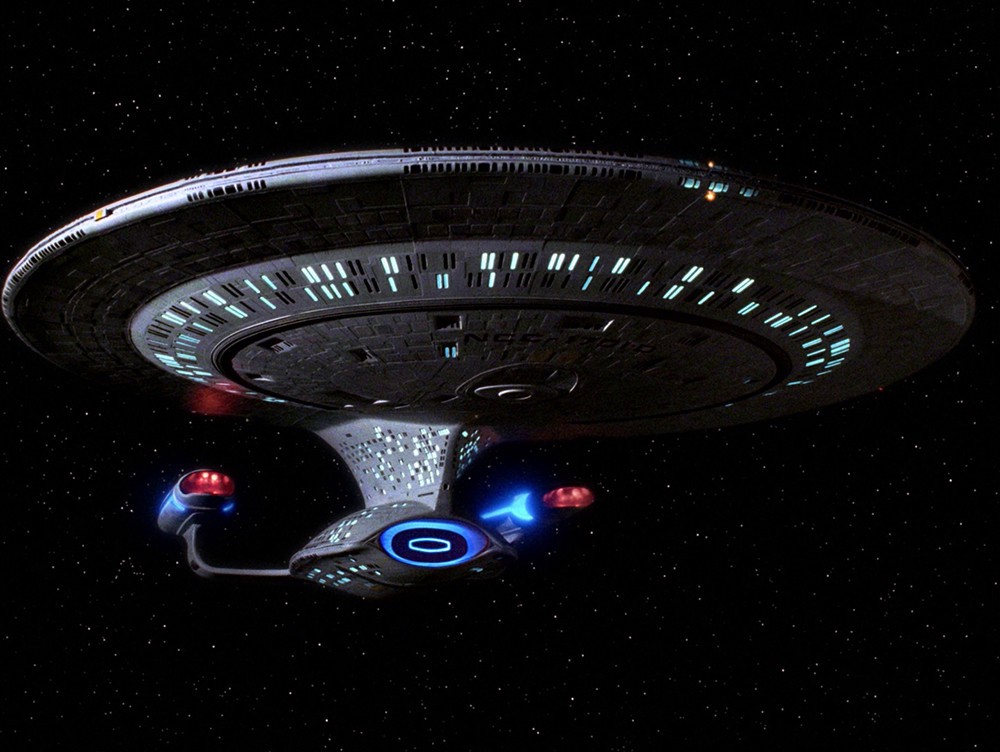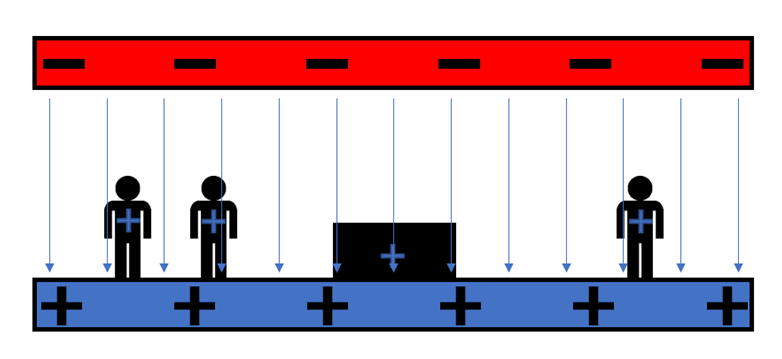
While examining their annual business reports, Starfleet has come to realize that the USS Enterprise-D is way over budget. The culprit: her artificial gravity generators, which are sucking up more resources than her warp drives, transporters, and ten-forward combined. Picard tries to point out the fact that the Enterprise single-handedly blew up a Borg cube last year which nearly destroyed the entire human race, but Starfleet holds fast to the conclusion that if the Enterprise can’t halve her resource expenditure by the end of the month, the vessel is to be mothballed. Picard knows that the artificial gravity generators are power guzzlers, but without some form of artificial gravity his crew could lose up to 20% of their muscle mass in less than a week, and would begin to shed bone tissue at a rate of 1.5% per month. Furthermore, long term exposure to microgravity is known to cause atrophy of the heart, leading to a lack of oxygen to the brain resulting in a crew unable to engage in their duties. Finally, extended stay in zero-gravity environments affects the human sleep cycle and the acuteness of our senses, and is also just generally harder to function in for a being which has evolved to operate in 1-g.
Picard understands that he needs artificial gravity for his crew, but wonders if perhaps there is a better alternative than the methods they are using now. Fortunately for them, someone got bored again again, and decided to do a pile of research on all the possible methods of generating a consistent, 1-g downward force on the passengers of a long-duration, space-faring vessel. It turns out that conventional methods of generating artificial gravity may not be the limit with a touch of sci-fi ingenuity.
Pseudo-Artificial Gravity
Weighing his options, Picard first looks at methods of simulating a 1-g force without actually creating an acceleration field like gravity does. Probably the best alternative to gravity is electromagnetism. In this idea, the surfaces of the Enterprise could be manufactured to allow them to be magnetized, and all crew members would be issued magnetic boots calibrated to their own weight in order to accurately simulate the lifting force they experience on Earth. Magnetic boots would be versatile, and could allow multiple surfaces of a spacecraft to be utilized as walking/storage space, as opposed to being confined to a predesignated “floor”. In addition, electromagnetic boots could be toggled on or off in order for the crew to perform zero-g maneuvers.
Magnetic boots sound flawless in principle, but in fact defeat their own purpose in practice. While a person’s legs receive an adequate workout pulling the magnetic boots from the floor, no other part of the body experiences a downward force, and thus the body of a person wearing magnetic boots is still subject to the full effects of weightlessness. In addition, magnetic boots may actually prove dangerous during evasive maneuvers due to the fact that the crew’s feet would literally be anchored to the floor. To conceptualize this, imagine riding a carnival ride, but instead of a lap bar, you were strapped in by your feet in a standing position. Yikes. A more prudent solution could be an entire magnetic body suit designed to distribute this magnetic force across the whole body. Though such a suit may be more useful in combating some of the effects of muscle and bone degeneration, the bottom line is that the user’s organs, as well as several of the body’s internal bones and muscles, would still be subject to continuous microgravity.
A perhaps simpler, albeit more ridiculous method of pseudo-artificial gravity could be the use of wind or air pressure to keep the crew fastened to the floor of the vessel. In this design, Picard imagines powerful arrays of pushing fans in the “ceiling” of each deck, and equally powerful sucking fans installed under a grate beneath his crew’s feet. When activated, an extreme wind force pushes down on anything between the fans keeping objects and crew alike tightly bound to the floor, regardless of material property or other installed technology.
Aside from being unimaginably loud and power-hungry, this would still be a pretty horrible way of producing artificial gravity. For starters, any object within the air stream would inherently affect the flow of air around it, and thus the wind force on other objects nearby. Perhaps a starker issue, however, is the fact that the force of air pressure on an object or person is entirely dependent on the surface area of that object exposed to the flowing air. If the system was designed to exert about 1-g of force on the average (standing) human, it would need to produce a wind velocity of about 76 m/s, or 170 mph. This is all fine and dandy while the person is upright (and standing still, and not holding anything, and not having long hair), but what happens when said person tucks in for bed? The moment someone lays down for a nap, their exposed surface area increases by more than 5 fold, leading to a wind pressure on their body of over 5 times their own weight! This would essentially be the equivalent of trying to sleep in a hurricane with a gorilla on your chest. Captain Picard says no thank you.
True Artificial Gravity
Okay, enough about magnets and air. Let’s talk about actual, true artificial gravity: producing a 1-g field of acceleration that affects all objects of mass within it, regardless of charge or position. Probably the most practical means of producing true artificial gravity in space is via is centripetal motion, referred to as centripetal gravity. Centripetal gravity is an induced outward acceleration on an object which is being pulled in a circle attached to a central hub. This is the same effect that keeps water inside of a bucket when swung in a loop. In this idea, the spacecraft, or modules of the spacecraft, are built to rotate around a central hub which, when spun at the right rate, generates a perfectly uniform gravitational field on the inside surface of the rotating section. This force is experienced almost identically to natural gravity, effectively combating the consequences of microgravity.
Centripetal gravity may seem simple, but it’s no Andorian cakewalk. Because the force experienced by centripetal acceleration grows weaker the closer you are to the central hub, the radius of such a structure must be large compared to the height of an average human so that the forces experienced at one’s head are roughly the same as the forces at their feet. Even a two-story tall ring spinning fast enough to generate 1-g at its surface will only impose about 0.63 g’s on a person’s head; a difference substantial enough to cause blood to pool in the head leading to nausea and disorientation. This means any spacecraft which plans to utilize centripetal gravity must have modules which are quite distant from the central hub to be practical, equating to a spacecraft which is larger, heavier, and less fuel efficient. Though a ring-shaped starship may be harder for the Cardassians to hit, Picard has reservations about yet another redesign of the Enterprise (they’re running out of letters, after all).
Perhaps a better alternative for true artificial gravity would be linear acceleration. Anything which accelerates imposes a constant force on anything within it in the opposite direction. This is the same effect that pushes you into your car seat when you slam on the gas pedal down the acceleration ramp at 3 am cause there’s no cops around. The idea here would be utilizing some form of propulsion to generate a continuous, 1-g acceleration towards your destination for half of the voyage, and then to spin around to decelerate at the same rate for the remainder of the voyage. Because the vessel would always be under acceleration in the direction of the front of the ship, all occupants would be pulled downward, towards the back of the ship. The biggest danger here is the fact that the propulsion system and the artificial gravity would be inherently tied together, meaning that if the propulsion system was somehow damaged, artificial gravity would be lost as well. Seeing as the Enterprise suffers engine damage just about every week, Picard continues his fruitless search.
Then again, why does the gravity have to be “artificial”? All objects of mass generate gravity, and the strength of this gravity is determined by two things: the amount of mass, and the distance you are from that mass. On Earth, at a distance of 6371 kilometers from the core, the strength of gravity is 1-g. Now we can’t go closer to Earth without being inside it, but if Earth could be condensed down to a point, the strength of gravity would continue to grow the closer you got to it. This means that objects smaller than Earth can still generate an Earth-strength gravitational pull, provided they are small and dense enough. Enter black holes.
By constructing a starship in a sphere of appropriate radius around an artificial black hole, you may not only have access to a reliable power source, but perhaps a means of artificial gravity as well. Occupants of the vessel would live on the outside of the sphere, pulled down by the gravity of the black hole inside. Similar to the issues with centripetal gravity from before, the gravitational gradient around a black hole changes quickly, so the sphere cannot be built too small or the difference in gravity between a person’s feet and head would be dangerously large. For a sphere with a radius of 50 meters, a micro black hole with about the same mass as a 5 kilometer asteroid is needed to generate 1-g of acceleration at the shell’s surface. All things considered, Starfleet isn’t too keen on creating and containing an artificial black hole, finding a way to maneuver a starship with the mass of a 5 kilometer asteroid, or getting past the patent that the Romulans already have on this technology.
Hypothetical Artificial Gravity
Picard is on his last leg. Sipping on Earl Grey, he wonders if there is any way that he can mimic the effects of the Enterprise’s artificial gravity generators without adverse side-effects to his crew, or a complete redesign of his ship. Well it turns out that there just might be, but it all depends on the existence of an exotic variety of hypothetical matter: negative mass.
In the late 50’s and early 60’s, physicists Hermann Bondi and William Bonnor were the first to mathematically describe the predicted gravitational properties of negative mass with respect to regular, positive mass. They concluded that objects of positive mass attract everything with any magnitude of mass (positive or negative), and that objects of negative mass would repel. This explanation, however, generated a paradox. Imagine, for a moment, two objects of equal but opposite mass, one that is +1 kg and the other -1 kg, sitting 1 meter apart. By Bondi and Bonnor’s predictions, the positive mass object will attract the negative mass object, and pull it towards it. However, at exactly the same rate, the negative mass object pushes on the positive mass object in the same direction. Together, the two objects begin to accelerate, and will continue to accelerate forever towards the speed of light with no mass or energy expenditure. This conundrum became known as the “runaway motion” paradox. The paradox went unresolved for over a decade, until quantum mechanics offered a new solution where like-magnitudes of mass attract each other, and opposites repel.
The existence of negative mass could provide the means to many hypothetical technologies including wormholes and warp drives, but Picard already has these. He is more interested in negative mass’s application in generating artificial gravity. In principle, the idea would work similarly to an electrical capacitor. However instead of differently charged plates affecting the motion of charged particles, a “mass capacitor” would host two plates with opposite magnitudes of mass. The positive mass plate would pull normal matter towards it, making it the “floor”, while negative mass plate would force normal matter away from it. The strength of this pull would be determined by the mass of the two plates. Since gravity is so much weaker than electromagnetism, the mass of the positive plate would have to be enormous to simulate an Earth-like gravity, but the negative plate would have exactly the same amount of negative mass, perfectly cancelling it out.
Aside from negative mass being entirely hypothetical, the mass capacitor suffers from one huge snag. Because negative and positive mass would inherently nullify each other on contact, there would be no structural device, positive or negative mass, capable of holding the two plates near each other without moving. A potential solution to this would be to build the positive mass portion of the ship in a spherical shell around the negative mass portion. Here, the negative mass sphere would be suspended at the center of the positive mass shell like a magnet, and would remain motionless with respect to the shell. With this design, the only constraint would be building a shell with a strength high enough to withstand the repulsive pressure from the negative mass.
Conclusion
Picard is just about to make his final decision when he receives a transmission from Starfleet command. Apparently the Klingon’s are getting restless at the Neutral Zone and, for some reason, they are the only ship in the quadrant. Picard barters a deal to keep the Enterprise’s artificial gravity generators for another year, then whizzes off towards the stars with his crew safely grounded. Starfleet rolls their eyes.
So there you have it. All my knowledge regarding the possible methods of generating artificial gravity for long term space travel in one document. Please don’t rail me, I’m not an actual physicist. I just really love math, technology, and learning new things!
Please remember we all have different opinions, Think Before You Speak or Write Something that is cruel to Others. After all, We are only Humans. Wishing you clear skies and wide eyes. To share your experiences or just leave a comment there is a area below. Read or listen.
We are the change the world has been waiting for!
Have you witnessed an unidentified flying object?
You are not alone. Whether you think UFOs are black projects, extraterrestrial craft, something else altogether, or just don’t know, again, you are not alone!
Unconditional love. The road we all get to walk. Unconditional love is like the sun.
WE ARE THE DISCLOSURE !~ WE HAVE NEVER BEEN ALONE
Love and Regards,
Thank You,
Nancy Thames
Source: Brandon Weigel







